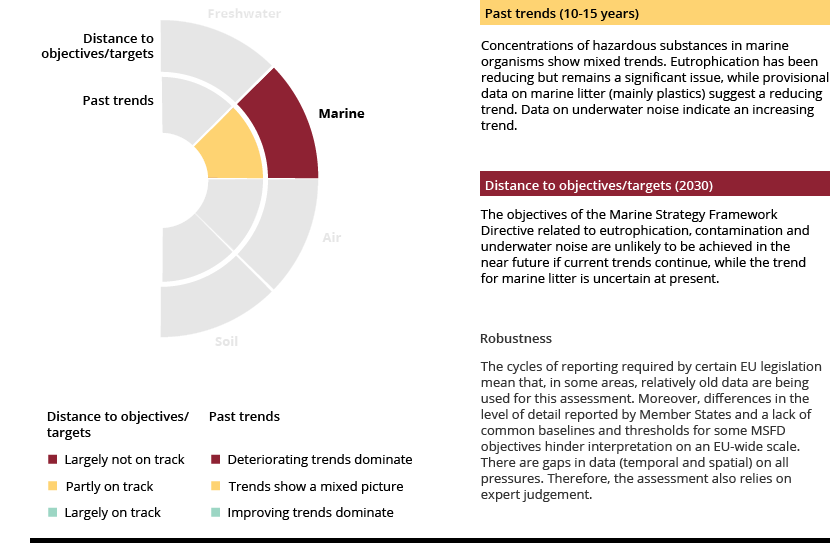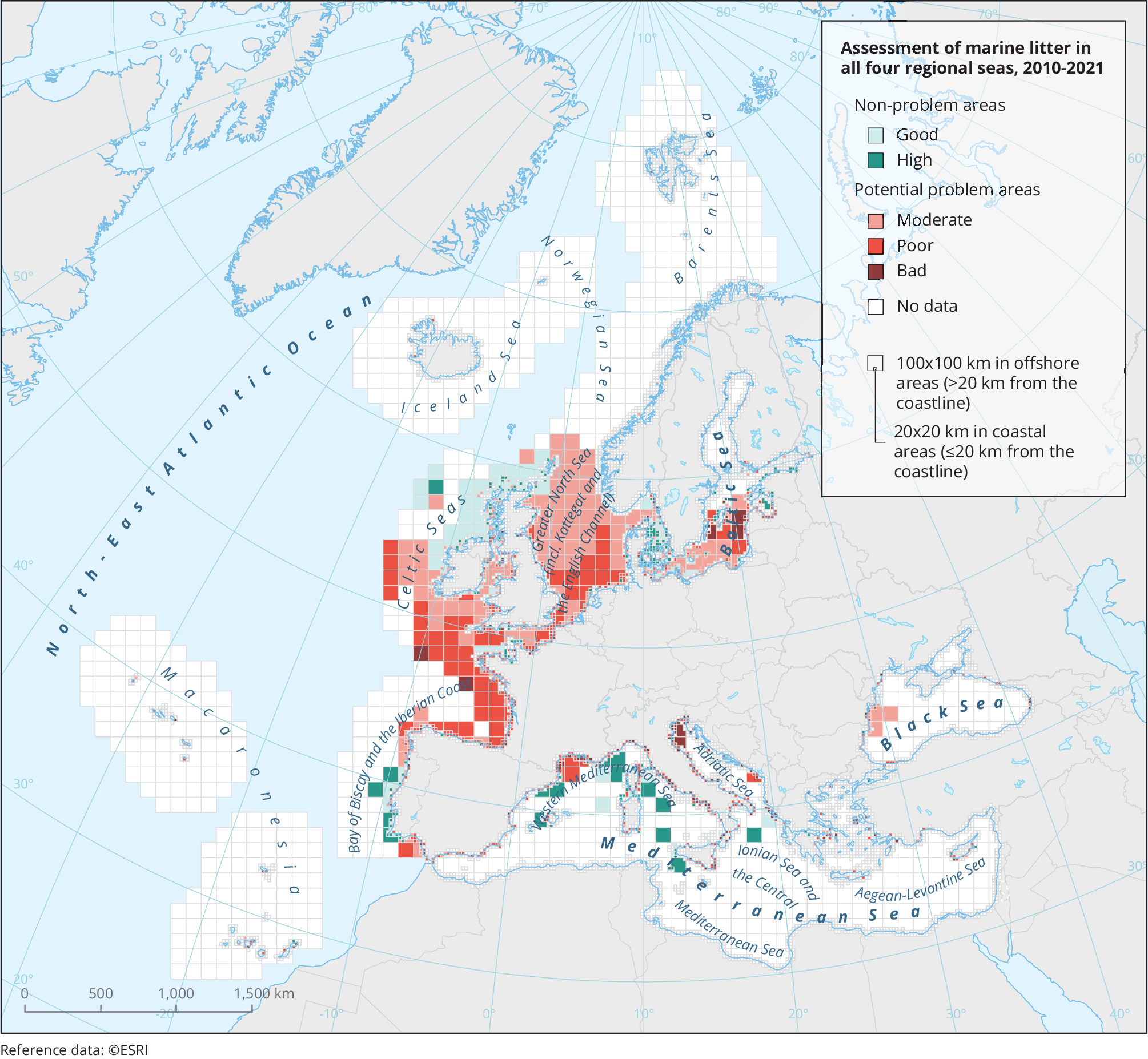
Guidance for interpreting the summary
The infographic above summarises the overall findings on marine pollution. Two distinct elements are considered:
- whether the past trend in pollution is positive, negative or uncertain
- the current 'distance to target', based on an assessment of the current trends or status and whether or not the EU is on track to achieve the defined zero pollution targets for 2030 and/or other relevant policy targets.
The analysis is based on a combination of (1) available indicators and data, as presented below, and (2) expert judgement.
Introduction
Europe relies on its seas for transport, energy, food, income and leisure, and a number of less well‑recognised ecosystems services, such as contributing to the oxygen in the air we breathe and carbon sequestration (EEA, 2019a). Coastal and maritime activities, such as fishing, shipping, tourism, aquaculture, and oil and gas extraction, exert multiple pressures on the marine environment. A key pressure is pollution. Pollutants are also transported into our seas from rivers and through atmospheric deposition.
A number of EU policies are designed to reduce marine ecosystem pollution, as explained in the EEA’s ‘Water and marine environment’. One such key instrument is the Marine Strategy Framework Directive (MSFD), which seeks to achieve good environmental status (GES) across a range of 11 objectives known as ‘descriptors’. These descriptors describe the criteria that must be met for GES to be achieved. For example, the eighth descriptor refers to contaminants being ‘at a level not giving rise to pollution effects’. The other descriptors cover a range of objectives, including eutrophication, seafood contamination, marine litter and underwater noise. However, there is no EU-level definition of what is considered GES, so Member States currently define their own thresholds. The analysis presented is based on the EEA’s preliminary estimation of GES, which in turn is based on the GES assessments reported by Member States.
Approximately 33% of the assessed areas in European seas do not have GES concerning eutrophication. It is similar for contamination (49%) and the problem is even worse for coastal marine litter (77%) (Map 2). Regarding underwater noise, reported data are not yet sufficient enough to draw conclusions from. The European Commission has initiated a review of the MSFD, which may lead to a proposal to revise the directive in 2023.

Notes: UPBT: ubiquitous, persistent, bioaccumulative and toxic substance.
The spatial extent of the GES assessment areas was defined as the marine waters surrounding the EU countries whose outer limit is defined by the 200 nm boundary from the coast, and the map does not show "not assessed" areas as the assessment is aggregated on the Marine Region scale.
Source: Based on WISE Marine’s “Marine Strategy Framework Directive – Good Environmental Status” dashboard (forthcoming).
Click here for different chart formats and data
Contamination of Europe’s seas
The current condition of Europe’s seas — from the Baltic to the Mediterranean — is generally poor (EEA, 2019a). Despite some positive developments achieved through regional cooperation, pollution from historical and current human activities (combined with other factors, such as climate change) could potentially lead to abrupt and irreversible damage to marine ecosystems (EEA, 2018). All four regional seas, i.e. the Baltic Sea, the Mediterranean Sea, the Black Sea and the North-East Atlantic Ocean, have large-scale contamination problems (EEA, 2018). Of the areas assessed, 80% are designated as problem areas in terms of contamination (EEA, 2019a), as shown in Map 3. An area is designated as a ‘problem area’ if there is evidence of an undesirable disturbance to the marine ecosystem due to inputs of contaminants. A specific methodology developed by the EEA clearly defines problem areas (EEA, 2018). The main pollutant groups causing this are heavy metals and synthetic chemicals such as organobromines.

Note: The majority of data is for the period 2008 to 2017. A limited amount of data from 2000 to 2005 is also used.
Source: EEA (2018).
Click here for different chart formats and data
Contaminants in marine organisms
Hazardous substances pollute European seas. Certain ‘legacy’ substances, such as polychlorinated biphenyls (PCBs) and mercury, still pose a significant threat to marine ecosystems, biota and human health through the food chain.
The EEA indicator ‘Hazardous substances in marine organisms in European seas’ assesses nine hazardous substances (nearly all of which have been banned) in mussels and oysters in the period 2010-2019. While environmental quality standards were exceeded for all nine hazardous substances at some locations, concentrations were low or moderate in general. Exceedances were seen most frequently for Benzo[α]pyrene, dichlorodiphenyldichloroethylene (DDE) and PCBs (EEA, 2022).
Sufficient data to identify trends were available for only the North-East Atlantic Ocean and the Baltic Sea. A stable or decreasing trend in hazardous substances was observed in the North-East Atlantic Ocean, while a stable trend was observed in the Baltic Sea.
Eutrophication of Europe’s seas
Eutrophication is caused by human activities that enrich waters with nutrients. Nutrient inputs (nitrogen, phosphorus and organic matter) primarily originate from land-based human activities (e.g. agricultural run-off and untreated urban wastewaters). Rivers are crucial pathways for carrying nutrient loads to the seas. Marine activities (e.g. aquaculture) and atmospheric deposition (as explained in the air pollution and ecosystems assessment) also contribute to excessive nutrient inputs. This results in excess nitrogen and phosphorus, which accelerate the growth of microalgae and higher forms of plant life. Ultimately, this growth results in various impacts such as loss of biodiversity, ecosystem degradation, harmful algal blooms and oxygen deficiency in waters.
Analysis carried out by the EEA indicates that just under one quarter (23.5%) of assessed areas are designated as problem areas in terms of nutrient enrichment and eutrophication, as illustrated in Map 4. However, for the Baltic Sea, this figure is 99% (EEA, 2019b). An EEA (2019b) report on nutrient enrichment and eutrophication in Europe’s seas identifies that nutrient loss, mainly from agriculture, is the main factor contributing to marine eutrophication.
Note: Mapping of spatial variations in the classifications of ‘nutrient levels’ based on available monitoring data, threshold values and the Heat+ assessment. Heat+ is the HELCOM Eutrophication Assessment Tool.
Source: EEA (2019b).
Click here for different chart formats and data
Plastic pollution in Europe’s seas
In addition to chemical pollution and eutrophication, marine litter is a significant problem in Europe. Plastics constitute the bulk of marine litter and are present in all marine ecosystems, with waste accumulating on shorelines, the seabed and surface waters. Further information on plastic pollution is available in the zero pollution cross-cutting story on plastics.
Marine litter harms marine biota through entanglement or ingestion, contaminant transfer and by acting as a transport vector for pollutants. Plastic and contaminant accumulation in marine biota and, potentially, the transfer of pathogens also threaten human health (Revel et al., 2018).
Single-use plastics represent 50% of all European beach litter items by count and fishing gear containing plastics accounts for a further 27%. Ingestion of plastics by marine species is also widespread in European seas. For example, 93% of fulmar birds assessed in the North-East Atlantic Ocean had ingested some plastic and 85% of turtles assessed in the Mediterranean Sea had ingested litter (EC, 2020, footnote 73).
Based on data for the period 2010-2021, almost 75% of assessed marine and coastal areas in Europe were designated as potential problem areas, as shown in Map 5 (EEA, forthcoming). For regional seas, the prevalence of potential problem areas was 83% (Baltic Sea), 78% (North-East Atlantic Ocean), 43% (Mediterranean Sea) and 98% (Black Sea). The EEA report Untold story of marine litter from source to sea (EEA, forthcoming) identifies sources of and pathways for marine litter.

Source: EEA, forthcoming.
Click here for different chart formats and data
Future EU coastline litter trend calculations will be based on harmonised data reported under the Marine Strategy Framework Directive. The large-scale monitoring and subsequent collection of these data through EMODnet has led to a consolidated dataset of litter on EU coastlines, provided and agreed upon by EU Member States. The years 2015 and 2016 have been selected as the baseline years for assessing progress against the zero pollution target of a 50% reduction in plastic litter at sea.
As the collection and analysis of the final 2015-2020 dataset are still being completed, it is not possible to provide a consolidated, agreed, EU-wide trend calculation. However, the European Commission Joint Research Centre (JRC) has provided a preliminary review of the available data. This indicates that concentrations of plastic litter are declining at most EU coastlines, which is an encouraging sign. There are some areas with increasing trends, which require further investigation. A more thorough assessment of this dataset will be published by JRC in 2023 and will be included in the next zero pollution monitoring assessment in 2024.
Marine noise
The impacts of underwater radiated noise on marine ecosystems have generally not been considered a priority pollution issue. However, there is increasing evidence of negative impacts and that continuous, anthropogenic underwater noise levels are significantly increasing. This topic is explored further in the accompanying zero pollution ‘Signal’ on continuous underwater noise.
Note: Link to indicators: Hazardous Substances in marine organisms in European Seas, Nutrients in transitional, coastal and marine waters in Europe, Chlorophyll in transitional, coastal and marine waters in Europe, Continuous underwater radiated noise (URN).
Overview of indicator analysis methodology
This indicator analysis is in line with the approach taken by the EEA for its seventh environment action programme monitoring.
Past trends are based on assessment of the trend over the last 10 years (or since the relevant zero pollution baseline year where appropriate) with green, yellow or red being applied based on the criteria as outlined in the figure legend. Expert judgement is also applied, for example in cases where indicators are more qualitative and/or uncertain.
The distance to target is based on an assessment of the recent trend, current status and expert judgement.
Further detailed analysis of the future outlook for meeting certain zero pollution targets is included in the zero pollution outlook 2022, completed by the European Commission Joint Research Centre (JRC, 2022).
References
EC, 2020, Report from the Commission to the European Parliament and Council on the implementation of the Marine Strategy Framework Directive (Directive 2008/56/EC) (COM(2020) 259 final of 25 June 2020) (https://eur-lex.europa.eu/legal-content/EN/TXT/PDF/?uri=CELEX:52020DC0259&from=EN) accessed 13 October 2022.
EEA, 2018, Contaminants in Europe’s seas — moving towards a clean, non-toxic marine environment, EEA Report No 25/2018, European Environment Agency (https://www.eea.europa.eu/publications/contaminants-in-europes-seas/).
EEA, 2019a, Marine messages II — navigating the course towards clean, healthy and productive seas through implementation of an ecosystem‑based approach, EEA Report No 17/2019, European Environment Agency (https://www.eea.europa.eu/publications/marine-messages-2/file) accessed 13 October 2022.
EEA, 2019b, Nutrient enrichment and eutrophication in Europe’s seas — moving towards a healthy marine environment, EEA Report No 14/2019, European Environment Agency (https://www.eea.europa.eu/publications/nutrient-enrichment-and-eutrophication-in).
EEA, 2022, ‘Hazardous substances in marine organisms in European seas’, European Environment Agency (https://www.eea.europa.eu/ims/hazardous-substances-in-marine-organisms) accessed 13 October 2022.
EEA, forthcoming, ‘Untold story of marine litter from source to sea’, European Environment Agency.
JRC, 2022, Zero pollution outlook 2022, JRC129655, Publications Office of the European Union, Luxembourg, Joint Research Centre (https://joint-research-centre.ec.europa.eu/zero-pollution-outlook-2022_en) accessed 1 December 2022.
Revel, M., et al., 2018, ‘Micro (nano) plastics: A threat to human health?’, Current Opinion in Environmental Science & Health 1, 17 (https://doi.org/10.1016/j.coesh.2017.10.003).
Cover image source: © Panagiotis Dalagiorgos, Well with Nature /EEA






Document Actions
Share with others